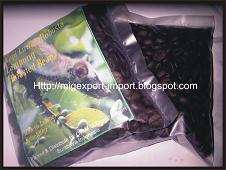Kopi luwak (Indonesian pronunciation), or civet coffee, is one of the world's most expensive and low-production varieties of coffee. It is made from the beans of coffee berries which have been eaten by the Indonesian Palm Civet (Paradoxurus hermaphroditus) and other related civets, then passed through its digestive tract.
A civet eats the berries for their fleshy pulp. In its stomach, proteolytic enzymes seep into the beans, making shorter peptides and more free amino acids. Passing through a civet's intestines the beans are then defecated, keeping their shape. After gathering, thorough washing, sun drying, light roasting and brewing, these beans yield an aromatic coffee with much less bitterness, widely noted as the most expensive coffee.
Kopi luwak is produced mainly on the islands of Sumatra (Lampung, Aceh, etc), Java (east, and west), Bali and Sulawesi in the Indonesian Archipelago.
The origin of Kopi Luwak is closely connected with the history of coffee production in Indonesia. In the early 18th century the Dutch established the cash-crop plantations in their colony in Dutch East Indies islands of Java and Sumatra, including Arabica coffee introduced from Yemen.
During the era of Cultuurstelsel (1830—1870), the Dutch prohibited the native farmers and plantation workers to pick coffee fruits for their own use. Yet the native farmers wanted to have a taste of the famed coffee beverage. Soon, the natives learned that certain species of musang or luwak (Asian Palm Civet) consumed these coffee fruits, yet they left the coffee seeds undigested in their droppings.
The natives collected these luwaks' coffee seed droppings, then cleaned, roasted and ground them to make their own coffee beverage. The fame of aromatic civet coffee spread from locals to Dutch plantation owners and soon become their favorite, yet because of its rarity and unusual process, the civet coffee was expensive even in colonial times.





